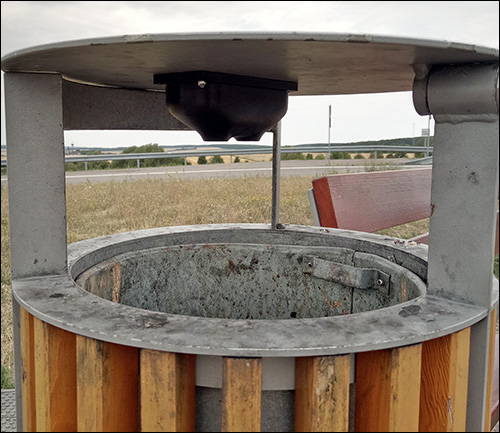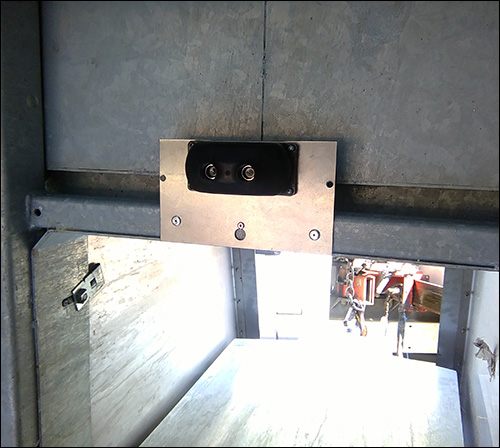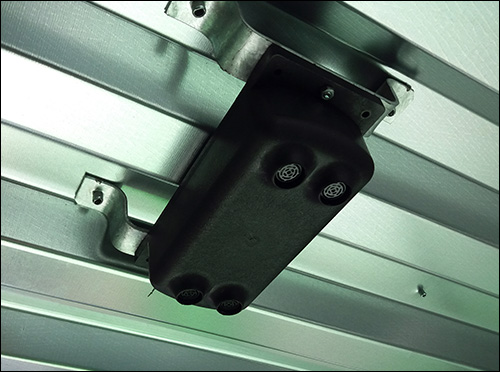A Slovakian technology company has developed a smart waste-management solution leveraging sensors in waste bins. The system, provided by Sensoneo, enables cities and waste operators to better manage their services based on each bin’s waste levels and conditions. It consists of ultrasonic-based Internet of Things (IoT) sensors that use wireless transmissions, such as LoRa, Sigfox, cellular or narrowband IoT (NB-IOT). The solution is currently being piloted by several companies throughout the United States, and has been deployed at dozens of sites around the world.
For waste-management companies, collecting waste from large public or commercial bins has traditionally been difficult to closely control. Sometimes, the bins do not contain enough waste to make the collection worthwhile, but the vehicles arrive onsite anyway. In other cases, the bins may be full long before a scheduled collection takes place.

With regard to recyclables, there is an incentive for companies to collect the discarded material while it is still high enough in quality to sell. But businesses rarely know when a bin might have been filled, and incidents sometimes happen, such as a lid blowing open and rain damaging or destroying the recyclable materials (cardboard, for instance) inside the bin.
Sensoneo is a spinoff from IT technology company BrainIT. The waste-management solution was released four years ago, and the company was launched independently in March 2017. The technology is now in use at 60 locations throughout 19 countries, according to Martin Basila, the firm’s founder and CTO.
The solution, Basila says, was developed to improve the efficiency of waste collection. This allows service providers to understand which bins require collection, as well as when and where, and to organize their vehicle dispatching and routes accordingly.
The Sensoneo solution consists of ultrasonic sensors installed within waste bins, along with a cloud-based solution to capture and manage data. Users can employ an app that enables waste-management companies and their customers (if so authorized) to access data on a smartphone or tablet regarding each bin and its location. The solution is being sold to partners, Basila says, such as systems integrators, IoT or mobile operators, and bin manufacturers.
The bin-agnostic solution fits everything from small street waste bins to high capacity containers, the company reports. The sensor device is typically installed on the upper inner wall, near the lid, with its ultrasonic beam aimed toward the bin’s lower center. When waste piles up, the ultrasonic beam is disturbed and the device transmits that event to the server.

The device includes more than ultrasonic sensors, however; it also has an accelerometer to identify when a bin is moved, as well as temperature sensors to identify any potential fire hazards inside a bin. In addition, a GPS function enables it to pinpoint the bin’s location. With a light sensor, the next-generation device can detect when the lid is open, which could potentially result in weather-based damage to recycling materials, or the scattering of refuse in a public area.
Once the system is deployed, the sensors—which have a battery life of about 10 years—typically transmit their data twice a day. That information can be sent via a variety of networks, Basila says, including cellular or LT450 systems, though the LoRa, Sigfox and NB-IOT systems have so far proved to be the best option for most deployments. The data is collected on Sensoneo’s cloud-based server using Microsoft‘s Azure platform. That, he notes, is where the system’s value is truly generated. “The magic is in the management of the data,” Basila states.
Waste-management companies can use the system to view the location of each bin on their service route, and to determine how full it is. The software also provides analytics and dispatching services. For instance, based on the locations of filled bins, it can recommend how many vehicles should be deployed, as well as the size of the vehicles and the order in which the bins should be collected. The system can also use GPS data from each vehicle in the waste-management solution to provide visibility into where they are located in real time, and where they have been. It can issue alerts as well, in the event that a bin is not emptied as expected.
Drivers can use a tablet and app to view their own route and progress. Field personnel who provide bin-maintenance checks can utilize the app to view the locations of receptacles, as well as their history, and to report the services they provide. A waste-management service provider’s customers could also be provided with access to the app, so that they could view when their bins are emptied or are scheduled to be emptied, and how full they are at any given moment.
With the analytical data, Basila says, the companies can determine how often the bins are being emptied at each site, along with whether or not they are using the proper number and size of vehicles to serve their customers properly. “Data is the key,” he states.

Installations typically begin with a three- to four-month pilot of the solution. In 90 percent of cases, Basila reports, users then deploy the technology permanently. Companies that have been using the system report that they are reducing costs by approximately 30 percent, due to requiring less fuel for vehicles and fewer man-hours for collection.
There is financial benefit for recyclers as well, Basila notes, as they can pick up materials before they become damaged (such as in the scenario of a rain-soaked bin with an open lid). Moreover, he adds, there is an environmental gain. “The vehicles can be big pollution producers,” he states, and reducing the mileage each vehicle covers offers a benefit in terms of air quality.
The company presently has several large-scale pilots under way, but the technology users have asked to remain unnamed. The firm is also working on customized sensors for some specific customers.

